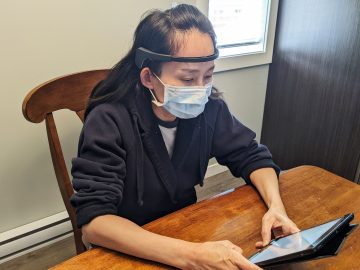Alison White (IMP Class of 2025) is intimately aware of the concern surrounding burnout in healthcare professionals. Before entering the MD program, she worked as an emergency nurse for three years.

Alison White (IMP Class of 2025)
“It was such a prevalent issue when I was working,” she says, adding the COVID-19 pandemic has made things even more complex. Not only did burnout adversely affect her and her fellow healthcare professionals, but it negatively impacted the quality of care they were able to provide for their patients. “That’s why I’m really interested in learning more about burnout in healthcare professionals and potentially finding out how we can mitigate it.”
Alison got her chance to do just that for her first-year FLEX project. Over the past year, she has participated in the Intervention to Prevent and Mitigate Burnout in Healthcare Professionals study led by Dr. Jane Gair (CBL Site Lead and Tutor Trainer, IMP; Teaching Professor, Division of Medical Sciences, UVic) and Dr. Olav Krigolson (Professor, Exercise Science, Physical & Health Education, UVic). Fellow MD student Judy Song (Vancouver Fraser Medical Program) also joined the project, as did UVic undergraduate students Madeline Antony, Darian Colpitts, and Bennett Chiu.
The study explores the use of mindfulness as an intervention to address the healthcare burnout epidemic. When someone cultivates mindfulness, they are able to enter a state in which they are fully present. Instead of holding onto the pressures of work and other stressors that can lead to burnout, they are aware and focused on where they are and what they are doing, and they are not overly reactive or overwhelmed by what is going on around them.
“A lot of the time in our day-to-day life – especially in modern, Western society – we’re not really in the moment, focusing on the present and what we’re actually doing,” says Alison. “We’re thinking about the last thing we did or an email we need to send or our to-do-list for later in the day. That can take a really big toll on our brain and our ability to truly relax.”
Previous research suggests that mindfulness-based stress reduction (MBSR), a program created in the 1970s, and other mindfulness interventions can help reduce burnout. However, Dr. Gair notes that many of these studies were limited by a variety of factors, including lack of active control groups, non-random assignment to groups, few data collection methods, and high dropout rates.
When designing their own study, Alison says the team tried to address many of these shortcomings. First, they randomly assigned the 25 participants—which included physicians, nurses, clinical pharmacists, social workers, medical lab techs, and medical office assistants—as much as possible (though they had to accommodate a few people due to scheduling conflicts). Second, they created three participant groups: an inactive control group, an active control group that learned general stress-management and stress-reduction techniques from Dr. Gair, and an intervention group that attended a mindfulness program taught by Victoria-based counsellor Ocean Lum.
“There has been a gap in the research for many years where there has not been an active control group as part of many study designs,” says Dr. Gair about the three-armed approach. “In most cases, participants either received mindfulness training or they didn’t. I wanted to add that element to this project and address that gap.”
Alison adds that when looking at previous research, it was tough to determine if the benefits that the study participants gained derived from the mindfulness lessons or from going to a group-based self-improvement class. By having the active control and intervention groups in their own study share common variables like being a group environment, having the same amount of therapy time, and offering a therapeutic alliance, the team was able to directly compare the benefits of mindfulness to those of the general stress-management course.
Finally, the research team collected their data on the effects of their mindfulness and stress-management courses using several different methods. Alongside the usual subjective self-reported questionnaires and survey tools, they gathered objective measurements using MUSE, a portable electroencephalogram (EEG) device used by Dr. Krigolson’s lab.

Felicia Chen demonstrates how research participants used the MUSE headset while participating in the Intervention to Prevent and Mitigate Burnout in Healthcare Professionals study. Photo by Bennett Chiu
“MUSE measures EEG, or ‘brain waves,’” says Dr. Krigolson. “We stream the data to software we developed that uses mathematical algorithms to identify different brain states.” In this study, MUSE could show if the mindfulness and / or stress-management classes helped someone become less burnt out by measuring the differences in their neural activity.
“It’s a really interesting piece of technology,” says Alison, who learned how to use MUSE for the study. “Coming from a hospital setting, I’m used to EEGs having multiple electrodes, gel placements, and all that. It’s super interesting to see that they can collect meaningful data with just the four electrodes in the headband.”
Alison says that collecting objective data for burnout is important because “your personal perspective isn’t always the same as your test results.”
“I know from working in healthcare that some people who experience burnout symptoms will still feel that they are not truly burnt out because they can still go to work,” she says. “But that doesn’t mean they’re not burnt out; it means they’re coping well.”
Alison and the rest of the research team have finished gathering data from the 19 participants who completed the study, and they are in the process of writing a paper on their findings. While she cannot disclose any data at this point, Alison says that there seems to be potential for both mindfulness and stress-management courses to help mitigate burnout. While she is particularly excited about the potential of mindfulness, she does note that this intervention may not be for everyone. “There are always going to be people who find mindfulness just doesn’t fit well with them,” she says. “Stress-management may be more accessible for some.”
No matter which intervention works for someone, getting help to alleviate the symptoms of burnout is the key. “Mitigation is always going to have an important role because it is something you can do personally to improve your own situation,” Alison says, adding that she sees mindfulness and stress-management practices as being only one part of a solution that should also include structural changes to the healthcare system.
“I may not have the power to go into work and make the five extra nurses and physicians that are needed appear, but at least I can go home and do something to help myself be more resilient to the current healthcare environment.”
